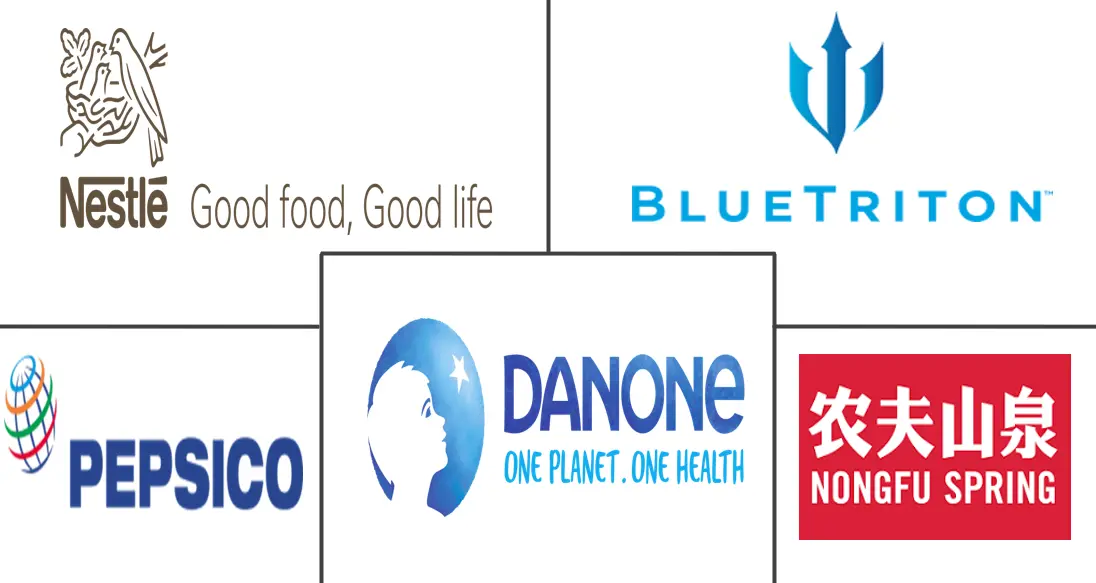Spring Water Market Size and Share
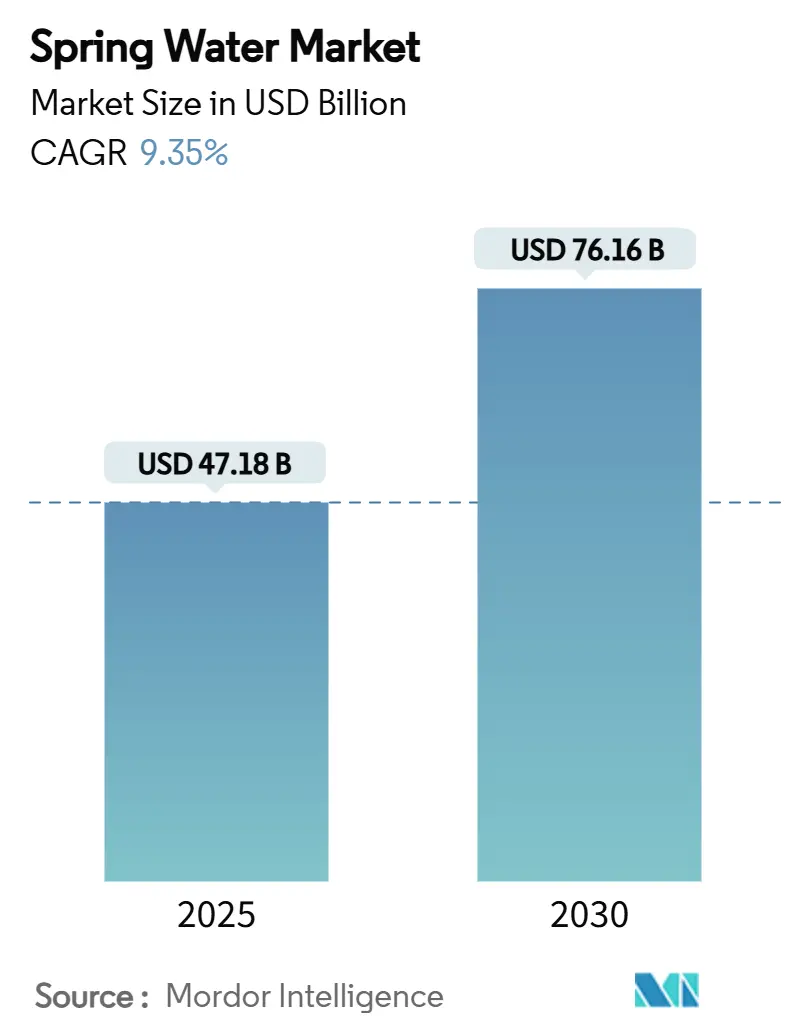
Spring Water Market Analysis by Mordor Intelligence
The spring water market size is expected to reach USD 47.18 billion in 2025 and is forecast to climb to USD 76.16 billion by 2030, reflecting a resilient 9.35% CAGR during the period. Continuous shifts toward low-calorie beverages, stricter quality oversight, and mounting environmental awareness underpin the expansion. European brands leverage regulatory leadership to position natural sources as premium, while North American suppliers combine vertical integration with digital engagement to defend volumes. Asia-Pacific’s urban middle class, accustomed to on-the-go lifestyles, fuels incremental demand for portable premium hydration. Packaging innovation and rising direct-to-consumer sales reshape competitive tactics, with aluminum cans and subscription models answering sustainability and convenience expectations. Consolidation—exemplified by the BlueTriton-Primo tie-up—signals the scale needed to manage compliance costs, safeguard watersheds, and finance product diversification.
Key Report Takeaways
- By packaging type, PET bottles dominated with 74.65% of 2024 revenue; aluminum cans are poised to grow at an 11.39% CAGR through 2030, the fastest rate among packaging formats.
- By product type, classic still water accounted for 93.43% of 2024 volume, while sparkling variants are projected to accelerate at a 9.71% CAGR to 2030.
- By distribution channel, supermarkets and hypermarkets led with 47.19% revenue share in 2024, whereas online and direct-to-consumer platforms are forecast to expand at a 14.39% CAGR to 2030.
- By geography, Europe held the largest share at 31.67% in 2024; Asia-Pacific is expected to deliver the highest regional CAGR at 10.11% through 2030.
Global Spring Water Market Trends and Insights
Drivers Impact Analysis
| Driver | (~) % Impact on CAGR Forecast | Geographic Relevance | Impact Timeline |
|---|---|---|---|
| Health-Conscious shift from Carbonated Drinks to Spring Water | +2.1% | Global, with strongest impact in North America & Europe | Medium term (2-4 years) |
| Perceived Purity and Mineral Profile of Spring Sources | +1.8% | Europe & North America core, expanding to APAC | Long term (≥ 4 years) |
| Emerging On-the-Go and Urban Lifestyles | +1.5% | APAC & MEA primary, urban centers globally | Short term (≤ 2 years) |
| Technological Advances in Water Purification | +1.2% | Global, with early adoption in developed markets | Medium term (2-4 years) |
| Premiumization and Functional Differentiation | +0.9% | North America & Europe, selective APAC markets | Long term (≥ 4 years) |
| Vertical spring-water farming for carbon-neutral sourcing | +0.8% | Europe & North America, pilot programs in APAC | Long term (≥ 4 years) |
| Source: Mordor Intelligence | |||
Health-Conscious shift from Carbonated Drinks to Spring Water
Bottled water has claimed the title of the top beverage category in the U.S. by volume, outpacing carbonated soft drinks for the first time in decades. This trend, which gained momentum from 2020 to 2024, saw U.S. per capita bottled water consumption hit 45.2 gallons annually, while carbonated drink consumption faced a decade-long decline[1]Source: International Bottled Water Association, “Bottled Water Statistics 2025,” ibwa.org. This shift underscores a growing health consciousness among consumers, who now equate spring water with natural minerals and a lack of artificial additives. Supporting this trend, Canadian data reveals that over 85% of children and teenagers consume water, in line with Health Canada's dietary guidelines. The trend shows no signs of waning, especially as younger generations lean more towards functional hydration, steering clear of sugary options. This evolving preference not only signals a consistent demand growth, irrespective of economic fluctuations, but also cements spring water's status as a resilient consumer staple, capable of commanding premium prices.
Perceived Purity and Mineral Profile of Spring Sources
Natural spring water, celebrated for its perceived purity, enjoys a premium status over processed alternatives. Regulatory definitions mandate that spring water be sourced directly from its natural points or extracted via boreholes from underground formations that surface naturally. Such regulations not only set barriers to market entry but also allow for genuine differentiation based on unique geological traits and mineral compositions. European markets, in particular, hold this distinction in high regard. Here, the EU Directive 2009/54/EC enforces stringent standards on source protection and treatment for natural mineral waters. Further bolstering these quality perceptions, the FDA recently tested 197 bottled water samples for PFAS, finding no spring water products surpassing the EPA's maximum contaminant levels. Consumers, willing to pay a premium for this perceived purity, inadvertently grant brands a sustainable competitive edge. This advantage is especially pronounced for established players boasting long-term access rights to sources and adept watershed management.
Emerging On-the-Go and Urban Lifestyles
As developing markets urbanize, there's a growing demand for convenient hydration solutions. In mature markets, single-serve PET packaging dominates, making up 71.3% of retail bottled water sales according to the International Bottled Water Association. This trend is even more pronounced in the Asia-Pacific region, where rapid urbanization and long commutes fuel a consistent demand for portable hydration. Such demographic shifts not only create predictable demand patterns but also pave the way for premium pricing and brand loyalty. Furthermore, this trend is spurring innovations in packaging, with aluminum cans becoming increasingly popular. Despite their higher production costs, aluminum cans are favored for their portability and recycling benefits. Given the ongoing industrialization and urban migration in developing markets, these trends in hydration solutions and packaging are set to continue.
Technological Advances in Water Purification
Spring water producers are increasingly turning to advanced purification technologies to ensure consistent quality while retaining the water's natural characteristics. Ozone treatment, applied at concentrations of 1.0-2.0 mg/L during bottling, has emerged as the industry standard. The International Bottled Water Association advocates for ozone, steering producers away from chlorine-based disinfection to sidestep chemical residues and potential taste alterations. Complementing this, UV disinfection and membrane filtration technologies bolster quality assurance, ensuring the mineral profiles that set spring water apart from processed varieties remain unchanged. The EPA has underscored the efficacy of ozone in industrial water treatment, noting its prowess against organic compounds and pathogens, all while upholding environmental safety benchmarks[2]Source: U.S. Environmental Protection Agency, “Ozone Treatment Guidance,” epa.gov. Such technological advancements empower producers to navigate tightening regulatory landscapes without compromising product authenticity. Moreover, as global monitoring of PFAS intensifies, investments in these advanced treatment systems not only ensure consistent quality and regulatory adherence but also carve out a competitive edge in the market.
Restraints Impact Analysis
| Restraint | (~) % Impact on CAGR Forecast | Geographic Relevance | Impact Timeline |
|---|---|---|---|
| Stringent and Evolving Regulatory Compliance | -1.4% | Global, with highest impact in Europe & North America | Medium term (2-4 years) |
| Substitute Products and Low-cost Home Filtration Systems | -0.7% | Developed markets primarily, expanding to urban APAC | Short term (≤ 2 years) |
| Environmental and Climate Threats to Water Quality | -0.6% | Global, with acute risks in water-stressed regions | Long term (≥ 4 years) |
| Rising Input and Raw Material Costs | -0.5% | Global, with regional variations in energy and packaging costs | Short term (≤ 2 years) |
| Source: Mordor Intelligence | |||
Stringent and Evolving Regulatory Compliance
As authorities tighten regulations, setting new contaminant limits and monitoring requirements, the EU's PFAS regulations are emerging as global benchmarks, demanding hefty compliance investments. In 2023, Germany's Drinking Water Ordinance imposed a stringent 0.1 µg/L limit on 20 perfluoroalkyl acids, posing technical hurdles for water analysis and treatment. Meanwhile, the FDA's proposed microbiological testing mandates for bottled water producers could lead to an estimated annual recordkeeping load of 179 hours[3]Source: Federal Register, “Proposed Rule on Bottled Water Microbial Testing 2024,” federalregister.gov. These tightening standards tend to benefit larger producers with robust compliance resources, sidelining smaller regional entities. With mounting environmental concerns and heightened consumer safety expectations, the push for stricter regulations shows no signs of waning, putting continued pressure on industry margins.
Substitute Products and Low-cost Home Filtration Systems Cannibalising Demand for Spring Water
In developed markets, where tap water quality often meets or surpasses that of bottled water, home filtration systems and enhancements to municipal water services are intensifying competition against bottled water consumption. The EPA, through its educational campaigns, underscores the environmental toll of bottled water from transportation emissions to plastic waste while advocating tap water as a sustainable choice. During inflationary periods, heightened consumer cost-awareness further bolsters this shift, as home filtration systems promise long-term savings over regular bottled water purchases. Data from NHANES reveals that tap water constitutes 62% of the total drinking water consumption in the U.S., with affluent demographics showing a pronounced preference for tap over bottled options. In response to this mounting pressure, spring water brands are pivoting, emphasizing unique attributes like mineral content, convenience, and taste, rather than just hydration. This challenge is particularly pronounced in regions witnessing upgrades to municipal water systems and a rising environmental awareness among consumers.
Segment Analysis
By Packaging Type: PET Dominance Faces Aluminum Challenge
The segment generated the largest portion of 2024 revenue, with PET maintaining 74.65% spring water market share owing to light weight, durability, and cost efficiency. Growing plastics backlash, however, drives aluminum’s 11.39% CAGR, buoyed by its 68% recycling rate compared with 3% for PET. Premium lines often migrate first, using sleek can designs to telegraph sustainability. While PET remains indispensable for price-sensitive markets, leading firms hedge with portfolio diversification and recycled-content goals. Production economics remain in flux, given can-sheet capacity constraints and volatile aluminum prices. Downstream, consumer willingness to pay higher shelf prices for metal packaging is being monitored carefully, particularly in emerging markets where price elasticity remains acute.
Heightened regulatory focus on single-use plastics accelerates corporate commitments to circularity. Coca-Cola and Danone pilot refillable PET in select European cities, yet the scale remains modest. Meanwhile, cross-industry competition for aluminum stock—sparked by craft beer growth—exposes bottlers to supply dislocations. Supply-chain integration, including offtake agreements with smelters, emerges as a strategic lever. Smaller brands limited to spot buying face cost pressure, potentially catalyzing further consolidation within the spring water market.
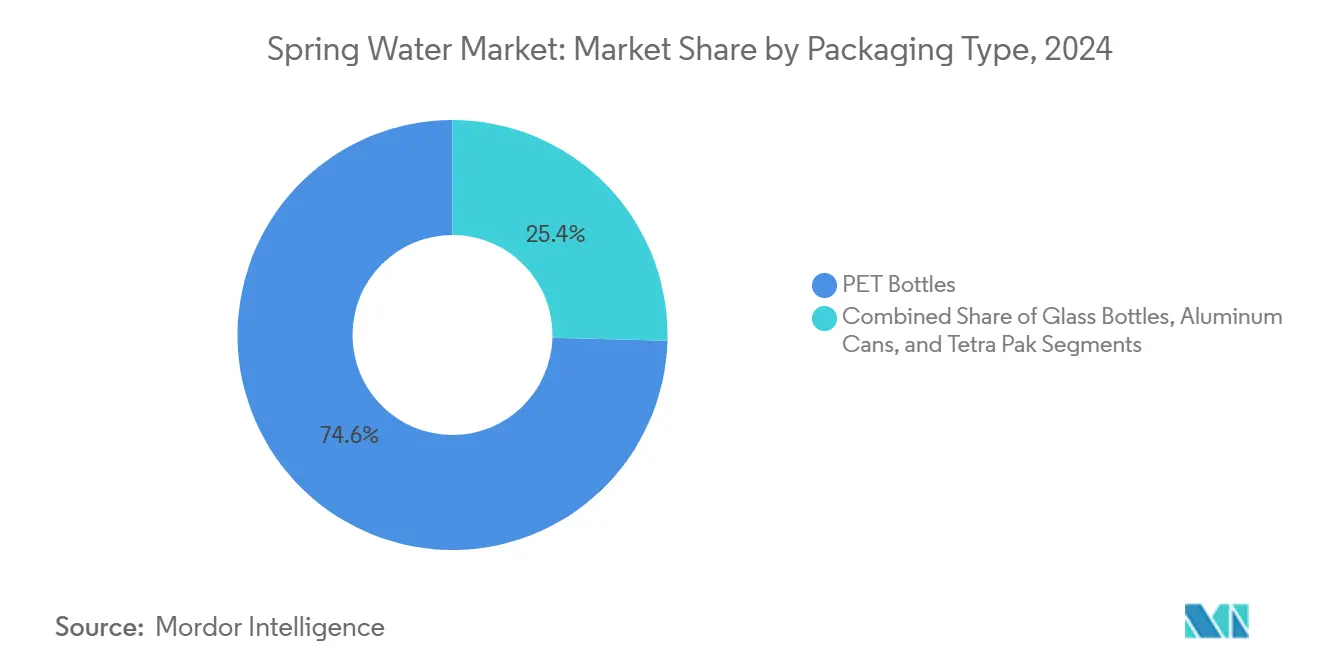
Note: Segment shares of all individual segments available upon report purchase
By Product Type: Still Water Supremacy with Sparkling Acceleration
Still variants accounted for 93.43% of the 2024 volume, confirming entrenched consumer preference for non-carbonated hydration. The segment anchors predictable cash flows essential for capital-intensive source protection. Sparkling water, though, now advances at a 9.71% CAGR, underpinned by flavor innovation and the appeal of natural carbonation among health-oriented millennials. Brands with rare effervescent aquifers, such as those in the Italian Alps, differentiate on provenance and micro-bubble mouthfeel. Value-added extensions, lime-infused or magnesium-rich, further propel unit margins, though they add formulation complexity and labeling scrutiny.
Nongfu Spring’s 2024 pivot into purified lines demonstrates portfolio elasticity when market tracking signals new volume pockets. Similar diversification is evident in Europe, where premium sparkling brands test low-sodium variants to capture sodium-conscious demographics without flavor compromise. Category blurring with functional beverages intensifies, yet regulators restrict additive lists for spring water, curbing experimentation. Marketing must balance authenticity narratives with the quest for novelty, a delicate act that larger incumbents manage through sub-brands to avoid diluting flagship purity.
By Distribution Channel: Traditional Retail Meets Digital Disruption
Supermarkets and hypermarkets retained 47.19% of 2024 turnover as household shoppers continued bulk restocking habits, aided by promotional end-caps and private-label offerings. Convenience stores and petrol marts cater to immediate consumption, but rising e-commerce penetration now reshapes replenishment. Online and direct-to-consumer sales are projected to rise at 14.39% CAGR as subscription models promise doorstep convenience and environmental footprint tracking. Controlled digital storefronts allow premium brands to explain source stories in richer multimedia detail, enhancing shopper education versus shelf labels.
The Coca-Cola Company reported 3% quarter-one 2025 water growth, largely attributable to digital campaigns in Asia-Pacific that tailored messaging to local languages and micro-influencer communities. Direct engagement also yields valuable consumption data, informing packaging sizes and flavor launches. Logistics, however, present cost hurdles for low-density bottled goods, prompting partnerships with quick-commerce platforms that aggregate last-mile routes. Retailers counter by expanding click-and-collect services, ensuring brick-and-mortar relevance amid shifting consumer expectations.

Note: Segment shares of all individual segments available upon report purchase
Geography Analysis
In 2024, Europe secures a 31.67% market share, bolstered by stringent quality regulations and a consumer shift towards natural mineral water. These factors bestow a sustainable edge to regional producers. The EU Directive 2009/54/EC enforces rigorous standards for natural mineral water, benefiting established brands with exclusive source access. Germany's DVGW is actively researching emerging contaminants, like Trifluoroacetic acid, underscoring the region's commitment to evolving regulations and quality leadership[4]Source: DVGW, “Emerging Contaminants in German Water Supplies,” dvgw.de. Meanwhile, Italy's MIPAAF and other agencies uphold food safety, extending their vigilance to spring water quality.
Asia-Pacific is on a rapid ascent, boasting a 10.11% CAGR projected through 2030. This surge is fueled by urbanization, increasing disposable incomes, and a health-conscious younger generation. In China, Nongfu Spring's commanding 23.6% market share highlights the competitive landscape and growth potential. South Korea's mineral water sector, with 62 registered manufacturers, has the capacity to extract 42,645 m3/day. Yet, with actual production at 14,172 m3/day, there's ample room for growth.
India and Southeast Asia are ripe with opportunities, as infrastructure advancements and growing incomes pave the way for premium beverage acceptance. In contrast, Japan and Australia serve as solid foundations for regional expansion endeavors. Navigating the region's varied regulatory landscapes demands a tailored approach, harmonizing global brand identity with local compliance. North America showcases a mature market with set consumption trends. Meanwhile, the Middle East and Africa, despite grappling with water scarcity, unveil opportunities that beckon innovative sourcing and distribution solutions.
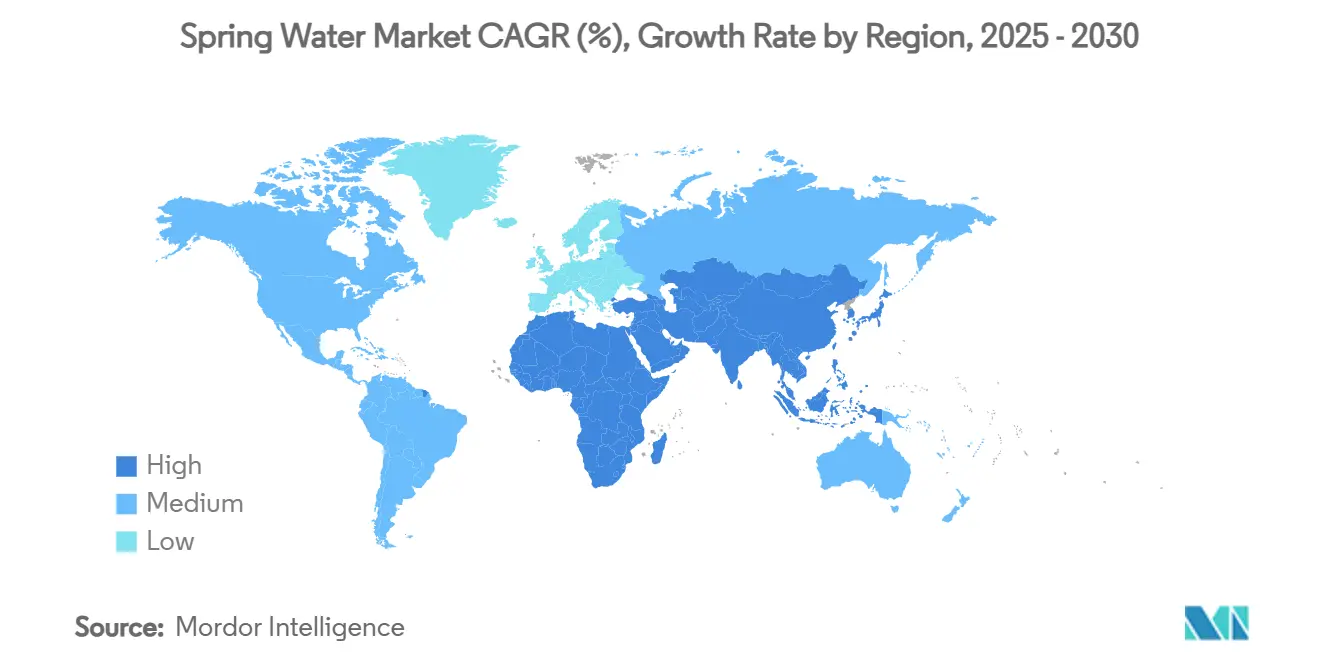
Competitive Landscape
The spring water market scores concentration scale, reflecting mid-level consolidation wherein the top five companies exert pronounced yet not monopolistic influence. Nestle S.A, Danone, BlueTriton Brands, PepsiCo, and Nongfu Spring, among others collectively control a significant share of global value through extensive source portfolios, multi-channel distribution, and heavy investment in returnable packaging lines. The BlueTriton-Primo combination, sealed in March 2025, elevates North American competition by integrating home-and-office delivery with retail brands. Economies of scale enable robust lobbying capacity and R&D spending that smaller bottlers find hard to match.
Sustainability credentials are now pivotal differentiators. Danone’s pledge to regenerate 100% of high-risk water basins by 2030, already achieving 159% replenishment in 2022, sets ambitious benchmarks. Such metrics are increasingly scrutinized by retailers and financiers, linking supply contracts and lending terms to measurable stewardship outcomes. Concurrently, technology investment—IoT sensors and blockchain traceability signals a shift toward data-rich compliance regimes that favor capitalized players.
Regional challengers sustain niche footholds by spotlighting unique terroir and limited-edition runs. Italian alpine micro-brands, for instance, capitalize on artisanal positioning and high mineral complexity, selling through gourmet channels at premium multiples. In Asia-Pacific, brands such as Fiji Water and Voss exploit image-driven marketing and celebrity endorsements to defend super-premium segments. Yet overhead escalation—in laboratory monitoring, emissions reductions and recycled content—pressures long-tail operators, spurring alliances or acquisitions.
Spring Water Industry Leaders
-
BlueTriton Brands
-
Nongfu Spring
-
PepsiCo Inc (Proud Source)
-
Nestle S.A
-
Danone SA
- *Disclaimer: Major Players sorted in no particular order
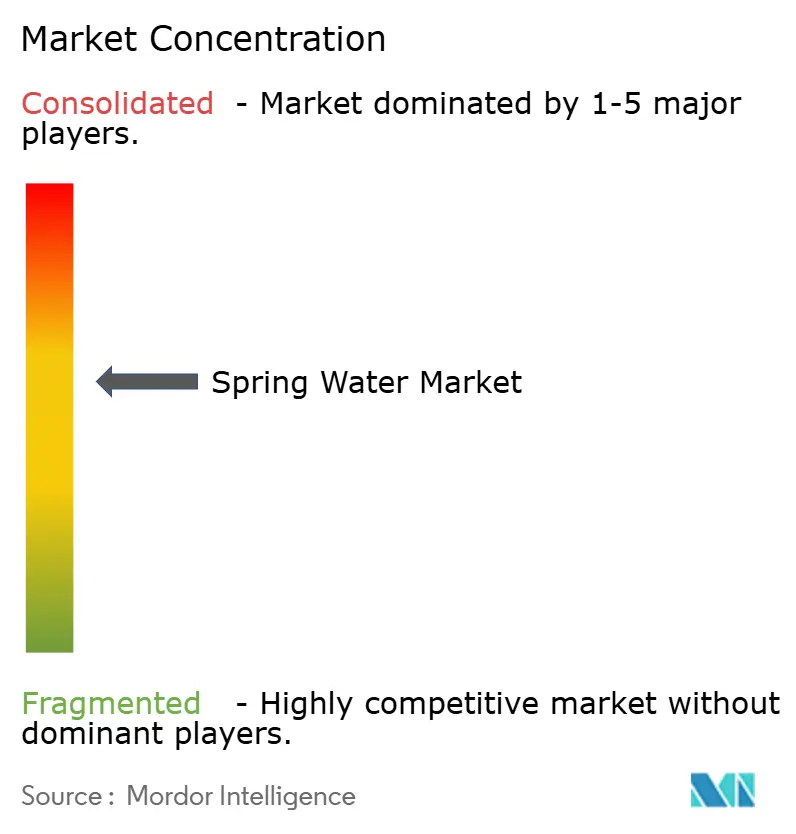
Recent Industry Developments
- April 2025: RAIN Pure Mountain Spring Water launched a 24-pack of aluminum-bottled spring water, targeting eco-conscious consumers and expanding availability across major U.S. retailers, including Kroger, Smart & Final, and West Marine
- October 2024: Water Almighty unveiled two new spring water products in aluminum bottles: Mighty Pure (triple-purified spring water) and Mighty Minerals (spring water enhanced with seven essential minerals), emphasizing sustainability and functionality in design and formulation.
- October 2024: Flow Beverage Corp. introduced Flow Sparkling Mineral Spring Water in 300ml aluminum bottles in Canada, with flavors like OG, Blackberry + Hibiscus, Lemon + Ginger, and Cucumber + Mint, using sustainable packaging featuring 70% recycled aluminum.
Global Spring Water Market Report Scope
| PET Bottles |
| Glass Bottles |
| Aluminum Cans |
| Tetra Pak |
| Classic Still Spring Water |
| Sparkling Spring Water |
| Flavored Spring Water |
| Other Spring Water |
| Supermarkets and Hypermarkets |
| Convenience/Grocery Stores |
| Online & Direct-to-Consumer |
| Other Off-Trade Channel |
| North America | United States |
| Canada | |
| Mexico | |
| Rest of North America | |
| Europe | Germany |
| United Kingdom | |
| Italy | |
| France | |
| Spain | |
| Netherlands | |
| Poland | |
| Belgium | |
| Sweden | |
| Rest of Europe | |
| Asia-Pacific | China |
| India | |
| Japan | |
| Australia | |
| Indonesia | |
| South Korea | |
| Thailand | |
| Singapore | |
| Rest of Asia-Pacific | |
| South America | Brazil |
| Argentina | |
| Colombia | |
| Chile | |
| Peru | |
| Rest of South America | |
| Middle East and Africa | South Africa |
| Saudi Arabia | |
| United Arab Emirates | |
| Nigeria | |
| Egypt | |
| Morocco | |
| Turkey | |
| Rest of Middle East and Africa |
| By Packaging Type | PET Bottles | |
| Glass Bottles | ||
| Aluminum Cans | ||
| Tetra Pak | ||
| By Product Type | Classic Still Spring Water | |
| Sparkling Spring Water | ||
| Flavored Spring Water | ||
| Other Spring Water | ||
| By Distribution Channel | Supermarkets and Hypermarkets | |
| Convenience/Grocery Stores | ||
| Online & Direct-to-Consumer | ||
| Other Off-Trade Channel | ||
| By Geography | North America | United States |
| Canada | ||
| Mexico | ||
| Rest of North America | ||
| Europe | Germany | |
| United Kingdom | ||
| Italy | ||
| France | ||
| Spain | ||
| Netherlands | ||
| Poland | ||
| Belgium | ||
| Sweden | ||
| Rest of Europe | ||
| Asia-Pacific | China | |
| India | ||
| Japan | ||
| Australia | ||
| Indonesia | ||
| South Korea | ||
| Thailand | ||
| Singapore | ||
| Rest of Asia-Pacific | ||
| South America | Brazil | |
| Argentina | ||
| Colombia | ||
| Chile | ||
| Peru | ||
| Rest of South America | ||
| Middle East and Africa | South Africa | |
| Saudi Arabia | ||
| United Arab Emirates | ||
| Nigeria | ||
| Egypt | ||
| Morocco | ||
| Turkey | ||
| Rest of Middle East and Africa | ||
Key Questions Answered in the Report
How large is the spring water market in 2025?
The spring water market size reached USD 47.18 billion in 2025 and is projected to grow steadily to USD 76.16 billion by 2030.
What is driving spring water demand?
Key factors include a sustained consumer shift away from sugary sodas, the perceived purity of natural sources, portable on-the-go consumption habits and continuous packaging innovation.
Which region leads the market and which grows fastest?
Europe leads with 31.67% market value due to strict quality norms, while Asia-Pacific registers the fastest CAGR at 10.11% through 2030.
What packaging format is gaining traction beyond PET?
Aluminum cans are the fastest-growing format at 11.39% CAGR, helped by higher recycling rates and premium positioning despite cost and supply challenges.
Page last updated on:
